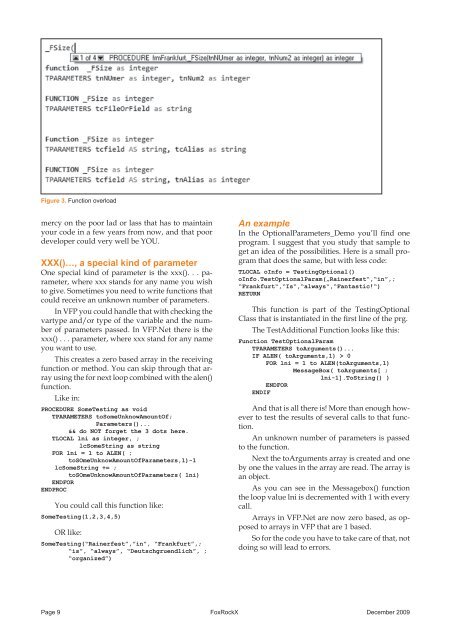You also want an ePaper? Increase the reach of your titles
YUMPU automatically turns print PDFs into web optimized ePapers that Google loves.
Figure 3. Function overload<br />
mercy on the poor lad or lass that has to maintain<br />
your code in a few years from now, and that poor<br />
developer could very well be YOU.<br />
XXX()…, a special kind of parameter<br />
One special kind of parameter is the xxx(). . . parameter,<br />
where xxx stands for any name you wish<br />
to give. Sometimes you need to write functions that<br />
could receive an unknown number of parameters.<br />
In VFP you could handle that with checking the<br />
vartype and/or type of the variable and the number<br />
of parameters passed. In VFP.Net there is the<br />
xxx() . . . parameter, where xxx stand for any name<br />
you want to use.<br />
This creates a zero based array in the receiving<br />
function or method. You can skip through that array<br />
using the for next loop combined with the alen()<br />
function.<br />
Like in:<br />
PROCEDURE SomeTesting as void<br />
TPARAMETERS toSomeUnknowAmountOf;<br />
Parameters()...<br />
&& do NOT forget the 3 dots here.<br />
TLOCAL lni as integer, ;<br />
lcSomeString as string<br />
FOR lni = 1 to ALEN( ;<br />
toSOmeUnknowAmountOfParameters,1)-1<br />
lcSomeString += ;<br />
toSOmeUnknowAmountOfParameters( lni)<br />
ENDFOR<br />
ENDPROC<br />
You could call this function like:<br />
SomeTesting(1,2,3,4,5)<br />
OR like:<br />
SomeTesting(“Rainerfest”,”in”, “Frankfurt”,;<br />
“is”, “always”, “Deutschgruendlich”, ;<br />
“organized”)<br />
An example<br />
In the OptionalParameters_Demo you’ll find one<br />
program. I suggest that you study that sample to<br />
get an idea of the possibilities. Here is a small program<br />
that does the same, but with less code:<br />
TLOCAL oInfo = TestingOptional()<br />
oInfo.TestOptionalParam(„Rainerfest“,“in”,;<br />
“Frankfurt“,“Is“,“always“,“Fantastic!“)<br />
RETURN<br />
This function is part of the TestingOptional<br />
Class that is instantiated in the first line of the prg.<br />
The TestAdditional Function looks like this:<br />
Function TestOptionalParam<br />
TPARAMETERS toArguments()...<br />
IF ALEN( toArguments,1) > 0<br />
FOR lni = 1 to ALEN(toArguments,1)<br />
MessageBox( toArguments[ ;<br />
lni-1].ToString() )<br />
ENDFOR<br />
ENDIF<br />
And that is all there is! More than enough however<br />
to test the results of several calls to that function.<br />
An unknown number of parameters is passed<br />
to the function.<br />
Next the toArguments array is created and one<br />
by one the values in the array are read. The array is<br />
an object.<br />
As you can see in the Messagebox() function<br />
the loop value lni is decremented with 1 with every<br />
call.<br />
Arrays in VFP.Net are now zero based, as opposed<br />
to arrays in VFP that are 1 based.<br />
So for the code you have to take care of that, not<br />
doing so will lead to errors.<br />
Page 9 FoxRockX December 2009
















